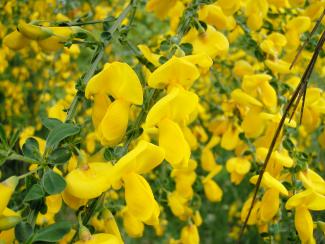Scotch Broom Sweeps Through BC: Limited Options for BC Individuals to Enforce Invasive Plant Control

Claire Qiu
Allard JD Candidate 2023
Jun 21, 2023

Many people may not know about Scotch broom, a highly flammable invasive plant spreading throughout southwest BC, nor its mortal enemy — the BroomBusters Invasive Plant Society. In June 2022, the non-profit organization expressed their frustration with government inaction in the face of BC Hydro letting the plant grow unchecked on lands occupied by its transmission lines. In their view, Scotch broom poses a serious wildfire risk and is a worsening problem that cannot be left to future generations.
BroomBusters made three demands: first, that BC categorize Scotch broom as a “noxious weed” pursuant to the Weed Control Act and Regulations; second, that BC legislate to control Scotch broom on Crown corporation and provincial lands; third, that local governments enact bylaws targeting the spread of Scotch broom.
In response, the Municipality of North Cowichan cited limited financial and staffing resources, in addition to the need to prioritize other invasive species, as barriers to legally enforcing the control of Scotch broom. The Municipality had planned to vote in support of a resolution calling for BC to categorize Scotch broom as noxious, but eventually decided against it. “If we can’t adopt this as a goal for ourselves, we probably shouldn’t be insisting that the province adopt it for the same reasons,” Councillor Christopher Justice said.
A Provincial Patchwork
Starting with the Weed Control Act, “Noxious weed” is defined to mean plants designated in Schedule A of the Weed Control Regulation. A plant may be a noxious weed throughout the province, or only in specified regions. Importantly, there is a statutory duty under section 2 of the Weed Control Act for persons, municipalities and governments to control noxious weeds on lands they occupy, under threat of penalty. This helps explain North Cowichan’s resistance to listing Scotch broom in the Regulation.
The Act may not be BroomBusters’ best hope for defeating Scotch broom. The Regulation, first introduced in 1985, originally had an agricultural focus. However, the most recent amendments in 2011 include urban noxious weeds such as giant hogweed. BC has added new plants infrequently, in 1999, 2001, and 2011.
BC’s province-wide policy does not favour eradicating Scotch broom or clearing it from areas where it has alread spread extensively. The province prioritizes invasive plants through its early detection and rapid response (EDRR) approach, which reserves eradication for high risk species that are not yet established in the province. The management objective for Scotch broom is “regional containment/control,” in other words to prevent further expansion into new areas.
Another problem is that provincial invasive plant regulation is divided amongst various ministries and pieces of legislation. It is hard to determine who or what is primarily responsible for particular problems, which is frustrating for members of the public looking to voice their concerns to the right bodies.
You might think that invasive plants are a predominantly environmental issue under the responsibility of the Ministry of Environment. However, the Weed Control Act itself is administered by the Ministry of Forests, whose portfolio also includes the Forest and Range Practices Act, which mandates that persons carrying out forest or range practices must control prescribed invasive plants, including Scotch broom.
The Ministry of Environment and Climate Change Strategy administers the Integrated Pest Management Act, as well as the Park Act. The former governs the use of pesticides, including products used against invasive plants. The latter’s prohibition against dumping indirectly targets invasive plants within parks, as people may dump yard waste containing plant seeds or cuttings. The Ecological Reserve Regulations prohibit the introduction of new species into ecological reserves without written permission from the administrator.

Additionally, the Ministry of Agriculture and Food administers the Plant Protection Act, which aims to prevent the spread of insects, pests or diseases that harm (desirable) plants.
In July 2020, the BC Minister of Environment acknowledged that experts were calling for a comprehensive invasive species act, but he would not “speculate” on what would occur.
Local Complications
Finally, local government powers to regulate invasive plants complicate matters even further.
Regional districts, under the Local Government Act, may pass bylaws that “require the owners or occupiers of real property, or their agents, to clear the property of brush, trees, noxious weeds or other growths”.
Under the Community Charter, municipalities may legislate in relation to the protection of the natural environment or to wildlife, but only with provincial government approval. The Spheres of Concurrent Jurisdiction — Environment and Wildlife Regulation contemplates that municipalities may pass bylaws regulating, prohibiting and imposing requirements in relation to specified “alien invasive species,” and Scotch broom is one of the specified species.

But there’s more. Municipalities can also use their power to regulate nuisances under the Community Charter. This allows them to get around the requirement for provincial approval, which matters if the municipality wants to target a plant not listed in provincial legislation. Citing this provision, the City of Coquitlam passed a bylaw that allows the city to require property owners to clear giant hogweed, even though giant hogweed is on the list in the Spheres of Concurrent Jurisdiction regulation.
Non-coercive options are also available. Both BC and local governments have given financial and other support to BroomBusters and other volunteer groups (e.g. Coquitlam’s “Bad Seeds” program). The Cariboo Regional District’s land owner assistance program provides financial and equipment-based support, as well as free private property assessments. Other local governments provide brochures about identifying and controlling invasive plants.
Judicial Limitations
If governments lack the resources or inclination to require and enforce control of a given invasive plant species, individuals have limited options. In a narrow range of situations, they may be able to resort to civil causes of action against parties who have failed to control plant growth.
For example, a person might be held liable for private nuisance if they allow an unwanted plant to encroach onto someone else’s property. In Parker v Hsieh, the Hsiehs knowingly allowed bamboo they had planted to invade Mr. Parker’s property. The bamboo was difficult to remove and sprouted up “throughout Mr. Parker’s well-manicured yard”. The court held that this was a substantial and unreasonable interference with Mr. Parker’s enjoyment of his land. The Hsiehs were therefore liable for nuisance.
Elements of nuisance can also apply through strata bylaw provisions. In McKnight v Bourque, Ms. McKnight, allowed her strata lot to become dilapidated, cluttered and overgrown with weeds, including Scotch broom, interfering with the Bourques’ ocean views and ability to attract buyers for their unit. The Civil Review Tribunal (CRT) found (and the BC Supreme Court agreed) that there was a substantial and unreasonable interference with the Bourques’ use of their property. Although the case was not directly about invasive species control, the CRT specifically noted the invasive nature of Scotch broom, as well as its potential aggravation of seawall erosion.
Unfortunately, private nuisance is an option only for property owners who care about invasive plants on their lands and have the energy and resources to go to court. But many owners and occupiers simply do not know or care about invasive plants.
An Uphill Struggle
Volunteer groups thus face a steep uphill battle in achieving invasive plant control, especially when BC will not commit to introducing comprehensive invasive species legislation or providing further funding. In the meantime, BroomBusters’ best bet may be to convince local governments that it is in their interest to enforce the control of Scotch broom in their respective jurisdictions using the existing powers available to them.
- Centre for Law and the Environment


